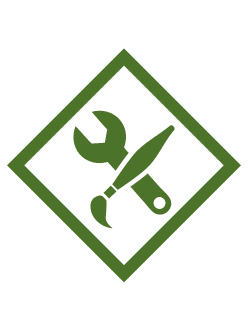Feedback
Feedback
Please provide feedback on your experience of this adventure or activity
Report Quality Assurance
If there are errors or issues with this adventure/ activity, please go to the Report Quality Assurance Page.
Adventure/Activity Feedback Form
This feedback helps identify things den leaders like and opportunities for improvement.
Webelos >
Tool Safety and Practice
Print This Page
Webelos – 4th Grade
Build It
Elective

Requirement 1
Tool Safety and Practice
Webelos – 4th Grade
Build It
Elective

Requirement 1
Tool Safety and Practice
Snapshot of Activity
Introduce Cub Scouts to basic tools and teach them use the tools safely.
Indoor
3
3
3
If you want to know more about The Adventure Activity Key click here.
Supply List
This Adventure Cub Scouts will learn how to safely use common tools. You may adjust this recommended list based on your available resources. Make sure to include tools that will be used to complete requirement 4.
- Power drill (For adult use only)
- 1/16” drill bit to drill pilot holes for screws
- ¾” drill bit for wrench activity
- 12-to-16-ounce claw hammer, one for each Cub Scout
- Philips head screwdriver, one for each Cub Scout
- Flathead screwdriver, one for each Cub Scout
- 20” hand saw, one for every two Cub Scouts
- 6” slip joint pliers, enough to share
- Standard wrench that fits the nut to the 2 ½” long ¾” carriage bolt, enough to share
- Socket wrench with a socket that fits the nut to the 2 ½” long ¾” carriage bolt, enough to share
- ½”, ¾”, OR 1” wood chisel, enough to share
- 1 awl
- 2 sheets of 60 grit sandpaper
- 2 sheets of 120 grit sandpaper
- 2 sheets of 220 grit sandpaper
- Measuring tape, enough to share
- Capenter’s square
- Level
- Vice or clamp Flat
- 1 lb box of 1 1/2” penny or common nails
- 50 – ½” wood screws, Philips head
- 50 – ½” wood screws, flathead
- 6 – 2 ½” long ¾” carriage bolts with nuts
- 1 ft long 1” x 4” pine, two per Cub Scout
- 1 ft long 2” x 4” pine, one per Cub Scout
- 1 ft long 2” x 4” pine, for wrench station
- 1 ft long 4” x 4” pine, for chisel and wood file station
- Rag or cloth, one per Cub Scout
- Safety glasses for each Cub Scout
- Timer
- Youth sized working gloves, one pair for each Cub Scout
- KN95 5-layer respirator masks, one for each Cub Scout
- First aid kit
Directions
Before the meeting:
- Secure enough tools to allow each Cub Scout to practice with. Ask parents and legal guardians if they have tools that can be used for this activity. If additional tools are needed ask other leaders and families in the pack.
- Ensure that there is at least one tool of each type listed in the Supply List and that each Cub Scout has a set of safety equipment
- Secure additional adult supervision as needed.
- Become familiar with the proper use of the tools you will be using by watching the following YouTube videos:
- A week before the meeting inform Cub Scouts, parents, and legal guardians of the activity and remind them to bring any tools they agreed to bring and that their Cub Scout wear closed-toed shoes.
- Pre-drill a few pilot holes for the screwdriver activity in the 1” x 4” boards.
- Take the 1 ft. long 2” x 4” and drill six ¾” holes equally spaced along the board. Insert the 2 ½” carriage bolts and place the board so the threads of the bolts where the nuts go are facing up. Place the nuts for each bolt next to each bolt.
- Set up meeting the space with stations that allow Cub Scouts to have room to safely use each tool. Each station should have the tools and wood that allows Cub Scouts to practice using the tool.
- Safety equipment check station: safety glasses, gloves, ear protection, and mask
- Hammer station: 6” long piece of 2” x 4” for each Cub Scout and 1” common penny nails 5 per Cub Scout
- Screwdriver and awl station
- Wrench station
- Chisel and sanding station
- Saw station
- Measuring tape, carpenter’s square, level, clamp, and vise
During the meeting:
- Gather Cub Scouts at the Safety Equipment Check station. Discuss each safety equipment
- Hand protection: Wear gloves necessary – handling wood, boxes of nails, etc. and ALWAYS position your fingers and thumb carefully when cutting.
- Eye Protection: Safety glasses are a must – ALWAYS AND ON EVERY PROJECT. If you wear prescription glasses, side shields can be purchased that slip onto the earpieces of the frame. This prevents debris and dust from entering your eyes from the side.
- Feet Protection: Wear good quality leather shoes with thick soles if possible. This type of show will protect your foot if something falls on it or prevent a puncture if you step on a nail. NEVER wear sandals, flip-flops, crocs, or open-toed shoes, etc.
- Nose and lung protection: Small dust particles can be inhaled quite easily through your nose and mouth. Cutting, sanding, drilling, etc., all create these particles.
- Assign adults to monitor each of the stations.
- Divide the Scouts into equal groups based on the number of stations and adult helpers. Have each group of Cub Scouts start at a different station:
- Hammer station:
Share with Cub Scouts that they will practice using their hammer. Demonstrate the proper use of a hammer to hammer a nail and how to use the claw to remove a nail. Hand out one piece of the 1” x 4” pieces of lumber. Have Cub Scouts see how many hits it takes to drive a nail into a piece of wood. Their parent or legal guardian can count. Next, have Cub Scouts see how many nails they can drive in five minutes. Set a timer and let them hammer for 5 minutes. Once stopped, have them count the number of nails and share with the den. - Screwdriver and awl station:
Demonstrate that you can use an awl to help start a hole for a screw. In this case share with the Cub Scouts, you drilled a hole smaller than the screw, this is called a pilot hole. A pilot hole will help prevent the wood from splitting when using a screw. Hand out the second piece of 1” x 4” board and have them use their screwdriver to screw in both a flathead and Phillips head screw. - Wrench station:
Inform the Cub Scouts that these are carriage bolts and nuts. To fasten a nut to the bolt you have several options. You could use slip join plyers, a standard wrench, or a socket wrench. Demonstrate each and then allow Cub Scouts to tighten and loosen the nuts using the plyers first, then the standard wrench, and then the socket wrench. Lead a discussion on which one they found the easiest to use. - Chisel and sanding station:
Explain to Cub Scouts that a chisel is used to carve away wood. Demonstrate the proper use of the chisel then let each Cub Scout practice on the 4” x 4”. Explain that sandpaper comes in different types that are measured in grits. The lower the grit number the rougher the sandpaper the higher the grit number the smoother the sandpaper. Lower grit sandpaper like 60 grit is used to remove paint or finish off wood or to shape wood. Medium grit sandpaper like 120 is also good for shaping wood. Fine grit sandpaper, like 220 is good to use before applying paint or to use in between coats of paint. Have Cub Scouts place their masks on and give each one a chance to sand a place on the 4” x 4” using each of the different grits of sandpaper and feel the differences it leaves on the wood. - Saw station:
Put on your mask and have Cub Scouts put on their masks as you demonstrate the proper way to sew. Hand out the 1” x 4” boards.
Starting with the 1” x 4” board, Cub Scouts use the hand saw to cut through the wood.
Have the Cub Scouts check their cuts to ensure they are straight and not slanted. - Measuring tape, carpenter’s square, level, clamp, and vise station:
Measure a piece of wood with the measuring tape. Examine how a level works and use a clamp to hold two pieces of wood together.
- After Cub Scouts have finished at their station, rotate everyone.
- After the activities above are completed, be sure to have each Cub Scout demonstrate the correct way to clean the last tool they used and how to store it.




